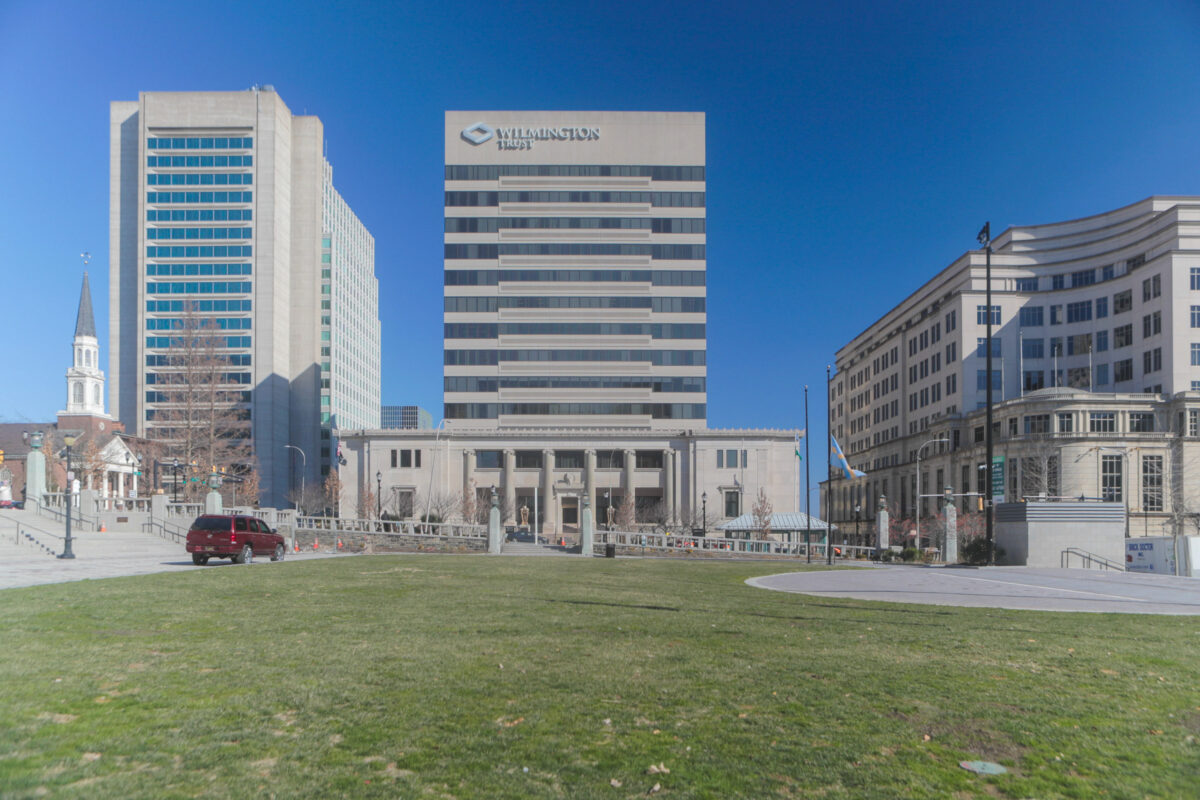Bracebridge, a relic of Downtown Wilmington, is finally getting new life.
Over the last few weeks, there have been big announcements from biopharmaceutical company Incyte and the philanthropic Longwood Foundation about Bracebridge.
The former MBNA campus defined Wilmington in the 90s, and now for the first time in years, there will be no vacancies in the six building complex. In a city that has struggled with empty commercial buildings and the loss of downtown vibrancy that comes with it, Incyte’s purchase alone is reducing the number of high-end vacancies by a third, according to some estimates.
Incyte announced last week that its moving into three of the buildings after its attempt to develop a campus in Alapocas failed. The Longwood Foundation, which helped turn Bracebridge IV into the Community Education Building in the ‘10s, plans to turn the remaining two buildings into a continuing education center called The Bridge. It’ll house programs from Widener Law School, Delaware State University and the University of Delaware, among others.
So, how did Bracebridge go from a banking HQ to a center of bioscience and education? Its story is, in many ways, the story of Wilmington’s business evolution over the last half century.
1980s: Stimulus for financial companies led them to settle in Delaware
The story starts in 1981, when the late Pierre S. du Pont, then governor of Delaware, signed The Financial Center Development Act to lift interest ceilings and provide tax breaks to banks.
At the time, Wilmington was still in recovery after the tumultuous ‘60s, including a nine month National Guard occupation. Getting companies to base themselves in Wilmington had been challenging, even with the state’s business-friendly incorporation laws.
The move worked: Banks flocked to Wilmington. In the 80s, the city became the credit card capital of the world, with a rising skyline to match. Its image, at least to corporations, improved but it was a nine to five commuter town that closed after work hours and offered little for the residents of the city, especially its youth. (As a teenager in the ‘80s, I often spent afternoons just walking around. There wasn’t much else to do.)
1990s: MBNA comes to Wilmington
The banking crisis of the late 80s impacted Wilmington by the end of the decade. As financial institutions were laying off employees and, in some cases, shutting down, a century-old bank called the Maryland Bank National Association (MBNA) was growing. It had set up a headquarters in Ogletown, Delaware, in a converted supermarket, to take advantage of the interest cap.
By the early ‘90s, MBNA was building Bracebridge, an ostentatious campus facing Rodney Square, as its headquarters. It brought thousands of jobs, and almost as many transplants, to Wilmington.
During the day, the city bustled with professionals from the suburbs. At night, businesses closed. The difference between investment in the predominantly suburban, wealthier commuter community versus the predominantly Black or Latino neighborhoods remained stark, and the city’s reputation reflected that.
2000s: A short-lived reign for MBNA, ING takes over for a bit
For the amount of work MBNA put into Wilmington, its major presence in the city lasted just a decade.
By the mid ‘00s, Bank of America (BOA) had acquired MBNA, and ING Direct, with its orange-themed Riverfront renovations, became Wilmington’s ‘It’ company. This takeover would also last just a decade. Still, ING Direct left some beautiful renovated buildings behind, now CSC Station, Tech Impact and Delaware State University’s Riverfront campus.
2010s: The vacancies and new renovations
In 2018, as BOA was moving its last Bracebridge employees to the suburbs, Technical.ly lamented another vacant building downtown and the loss of tax revenue. Still, Wilmington remained optimistic.
“Let’s hope that whoever buys I and III will bring in a lot of good, stable jobs,” I wrote at the time.”
Bracebridge IV was already being used as the Longwood Foundation’s Community Education Building. The education equity center directly supports children in Wilmington’s underserved communities as a shared space for Kuumba Academy and Great Oaks Charter Schools. But it was surrounded by massive, empty buildings.
2020s: The Bainbridge revival
Now, after years of vacancies, it’s finally happening: the Bracebridge complex will once again be a place that creates jobs.
Incyte alone is expected to bring 500 jobs to the city. The Bridge and CEB, which includes the headquarters of Code Differently, offer education and workforce development in a city that, while it’s still developing a more vibrant nightlife, no longer shuts down at 5.
It all means an influx of tax dollars for the city, but more than that, it means an once-vacant relic is on the road to being a more functioning part of the city, for the city.
➡️Read more
- Bank of America’s presence in the City of Wilmington is dwindling
- An ecosystem grows in Delaware: 15 years of tech and change, locally and beyond
- 13 innovative technologies being developed in Delaware
Disclosure: Longwood Foundation has provided philanthropic support to Technical.ly. That relationship had no bearing on this report.
Before you go...
Please consider supporting Technical.ly to keep our independent journalism strong. Unlike most business-focused media outlets, we don’t have a paywall. Instead, we count on your personal and organizational support.
Join our growing Slack community
Join 5,000 tech professionals and entrepreneurs in our community Slack today!






